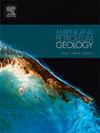受岩性和测井分辨率制约的致密砂岩孔隙度预测方法
IF 3.7
2区 地球科学
Q1 GEOSCIENCES, MULTIDISCIPLINARY
引用次数: 0
摘要
鄂尔多斯盆地上三叠统延长地层的资源潜力相当大。然而,由于致密砂岩的孔隙度和渗透率低、连通性差、异质性强,预测该地层致密砂岩的孔隙度面临巨大挑战。长 71 亚元的岩性以箭石岩和石质箭石岩为主,孔隙度主要介于 3% 与 13% 之间,孔隙类型主要为长石溶蚀孔隙。在岩心样品实验和薄片分析的基础上,结合常规测井曲线,我们提出了岩性控制下的三孔隙度加权平均预测方法,并开发了一种受测井分辨率控制的新型测井曲线读取方法。我们利用主成分分析优化测井曲线,减少测井曲线间复杂耦合关系对岩性识别的影响。应用随机森林和极梯度提升模型相结合的堆叠算法,将岩性划分为五类:均质-流道-细砂岩、异质-流道-细砂岩、均质-口-条细砂岩、异质-口-条细砂岩和浅湖泥岩。与基于测井的人工分类结果相比,岩性识别的准确率约为 94.2%。此外,还对四种岩性(即除浅湖泥岩外)的孔隙度曲线进行了敏感性分析,建立了各岩性的孔隙度模型,为准确预测孔隙度提供了有效、客观的方法。该预测方法综合考虑了沉积因素,并结合统计资料,采用多元线性回归拟合,具有较高的可靠性。在长 71 亚元中,预测孔隙度与岩心孔隙度的拟合度达到 0.912,表明这种基于岩性约束的三孔隙度加权平均法合理、可靠,与之前报道的方法相比具有更强的适应性。基于岩性控制和权重分析的预测方法可应用于其他致密砂岩,为油气勘探开发提供可靠的技术支持。本文章由计算机程序翻译,如有差异,请以英文原文为准。
Prediction method for the porosity of tight sandstone constrained by lithofacies and logging resolution
The resource potential of the Upper Triassic Yanchang Formation in the Ordos Basin is considerably large. However, owing to the low porosity and permeability, poor connectivity, and strong heterogeneity of tight sandstone, predicting the porosity of tight sandstone in this formation poses substantial challenges. The lithology of Chang 71 sub-member is dominated by arkose and lithic arkose, wherein the porosities mainly ranged between 3 and 13% and pore types were mainly feldspar dissolution pores. Based on core sample experiments and thin section analysis, combined with conventional logging curves, we proposed a three-porosity weighted average prediction method under lithological control, and a novel method for reading logging curves controlled by logging resolution is developed. We used principal component analysis to optimise the logging curves and reduce the impact of complex coupling relationships between logging curves on lithofacies identification. The stacking algorithm, which is a combination of the random forest and extreme gradient boosting models, was applied to divide the lithofacies into five categories: homogeneous-distributary-channel fine sandstone, heterogeneous-distributary-channel fine sandstone, homogeneous-mouth-bar fine sandstone, heterogeneous-mouth-bar fine sandstone, and shallow lacustrine mudstone. Compared with the results of manual classification based on logs, the accuracy of lithofacies recognition was approximately 94.2%. Additionally, sensitivity analysis of porosity curves was conducted on four types of lithofacies (i.e., except for shallow lacustrine mudstone), and porosity models for each lithofacies were established, providing an effective and objective method for the accurate prediction of porosity. This prediction method comprehensively considers sedimentary factors and incorporates statistics that are fitted using multiple linear regression, which is highly reliable. In the Chang 71 sub-member, the fitting degree between the predicted and core porosities reached 0.912, indicating that this three-porosity weighted average method based on lithofacies constraints is reasonable, reliable, and has stronger adaptability than the those reported previously. The prediction method based on lithofacies control and weight analysis can be applied to other tight sandstones, providing reliable technical support for oil and gas exploration and development.
求助全文
通过发布文献求助,成功后即可免费获取论文全文。
去求助
来源期刊

Marine and Petroleum Geology
地学-地球科学综合
CiteScore
8.80
自引率
14.30%
发文量
475
审稿时长
63 days
期刊介绍:
Marine and Petroleum Geology is the pre-eminent international forum for the exchange of multidisciplinary concepts, interpretations and techniques for all concerned with marine and petroleum geology in industry, government and academia. Rapid bimonthly publication allows early communications of papers or short communications to the geoscience community.
Marine and Petroleum Geology is essential reading for geologists, geophysicists and explorationists in industry, government and academia working in the following areas: marine geology; basin analysis and evaluation; organic geochemistry; reserve/resource estimation; seismic stratigraphy; thermal models of basic evolution; sedimentary geology; continental margins; geophysical interpretation; structural geology/tectonics; formation evaluation techniques; well logging.
 求助内容:
求助内容: 应助结果提醒方式:
应助结果提醒方式:


